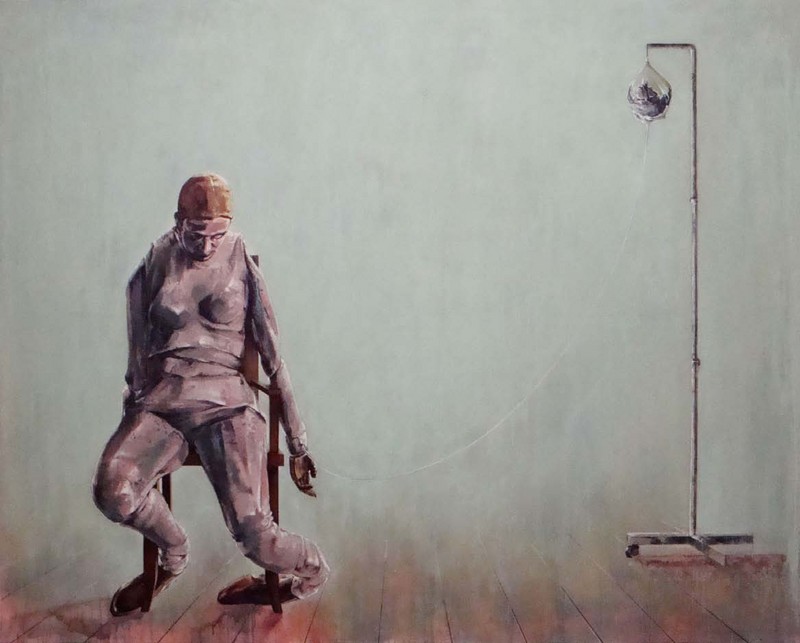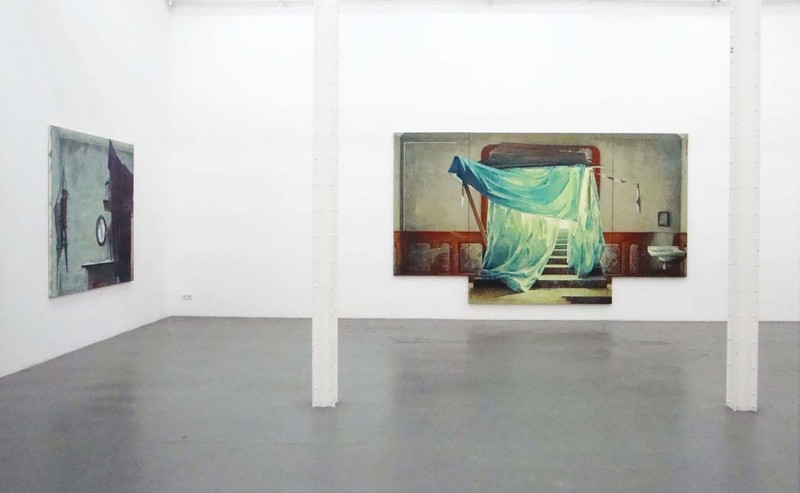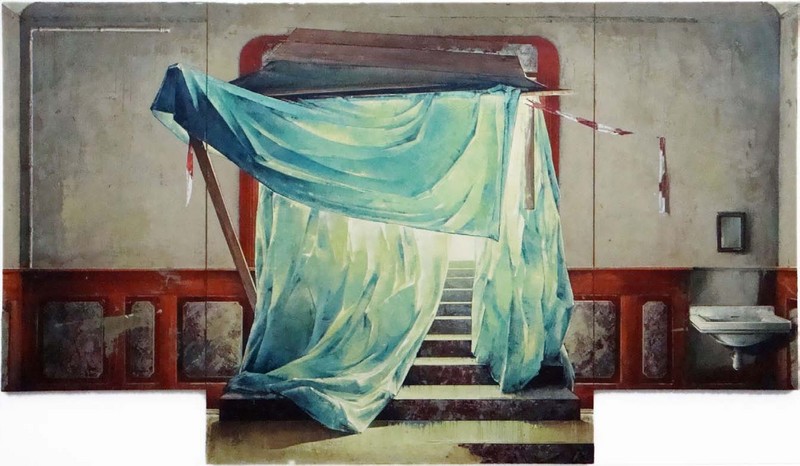Katrin Heichel VOTIV
17 Oct - 14 Nov 2009
Die Bedeutung von Materialität ist im Werk von Katrin Heichel ebenso wiederkehrend, wie ihre motivische Neigung populäre Bildwelten oder profane, spröde Gegenstände in ihren Bildern zu verwenden. Beide Ebenen offenbaren in ihrer Synthese den dahinter liegenden Sinn einer Aufwertung der ästhetischen „Stiefkinder“ durch die sinnliche Oberfläche, so dass sie wie Kostbarkeiten wirken.
In den italienischen Votivstätten begegnete Katrin Heichel nun einer ästhetischen Verwandtschaft: Wachsvotive von Körperteilen, Zettelchen, Bilder, die volkstümlich verankert sind, führen dieses Reich der Materialität zu einer Gesamterscheinung, die, nach den Worten der Künstlerin, ohne weiteres Biennale-würdig sei. Von Hunderten und tausenden von Bitten und Anrufungen, die als physische Hinterlassenschaft ein Exempel katholischer Materialpräsenz statuieren, geht nicht nur eine visuelle Kraft aus, sondern der visuelle Reiz verweist unmittelbar auf das dahinter liegende magische Ritual.
Katrin Heichel begibt sich in ihrem Zyklus VOTIV nicht in eingefahrene Gleise der Votiv-Ästhetik, sondern eignet sich weniger bekannte Symbole oder kuriose Seiten von Heiligen an, um sie in vergleichsweise klaren Bildräumen umzudeuten und mit ihrem persönlichen Leben zu verbinden.
So setzt sie etwa die Kröte, die als Symbol weiblicher Fruchtbarkeit an die Votivtafeln angebracht wurde, in eine Infusionsflasche, oder formuliert das Wachsbein (eine häufige Votivgabe) in ihren Bildern zur Prothese um. Sie verarbeitet den Heiligenkult in der Person des Donatus, der in bestimmten Regionen Süditaliens u.a. als Schutzheiliger behinderter Kinder verehrt wird. Das größte Bilder der Ausstellung zeigt eine barock anmutend Baustelle. Licht scheint hinter einer mit Blauplane drapierten Tür und weckt Assoziationen zu Dionysios Pseudo-Areopagitas Lichtmetaphysik.
Katholischer Mystizismus und der visuelle Ausdruck der Gläubigen bilden somit ein gedankliches Gerüst der Ausstellung, wobei die Ästhetik der Bilder Katrin Heichels durch die Klarheit der Bildräume eine erstaunliche Distanz zu den Urbildern einnehmen, was auch der inhaltlichen Auseinandersetzung entspricht, in der eine ganz eigene Sicht und Interpretation katholischer Materialpräsenz, Heiligenverehrung und neuplatonischer Lichtmetaphysik vorgenommen wird.
Lu Potemka
In Katrin Heichel's work, the meaning of materiality is as recurring as her motivic affinity to use popular picture worlds or profane, rough items in her paintings. In their synthesis both levels reveal the underlying sense of an aesthetic stepchildren upgrade through the sensual surface so that they appear as precious objects.
In the italian votive temples Katrin Heichel met an aesthetic relation: Wax votives of bodyparts, notes, pictures that are folksy rooted lead this kingdom of materiality to a general appearance which is, to quote the artist, Biennale worthy . Not only does a visual power radiate from the houndreds and thousands of pleadings and appeals, which make an example as physical inheritance for catholic material presence, but the visual attraction refers directly to the underlaying magical ritual, salso.
With her cycle, VOTIV Katrin Heichel does not proceed to finished tracks of the Votive-aesthetics, instead she makes less popular symbols or curious sides of saints her own to reinterpret them in comparativly clear figure worlds and to connect them with her personal life.
She puts, for instance, a toat, attached to the votive-boards as a symbol for female fertility, in an infusionbottle or restates the wax-leg (a frequent votive offering) in her paintings to a prothesis. She works up the cult of saints int the person of Donatus, who is, in certain regions of Southern Italy, worshiped inter alia as patron for handicaped children.
The largest painting of the exhibition shows a baroque seeming construction site. Light shines behind a door, draped with blue tarp and generates associations to Dionysios' Pseudo-Areopagitas light metaphysics. In this way catholic mysticism and the visual expression of the believers form a mental framework of the exhibition, whereas the aesthetic of Katrin Heichel's paintings occupies an astonishing distance to the primal-pictures through the clarity of the picturespaces, which also matches the contentual controversy in which a very own view and interpretation of catholic material presence, veneration of saints and neoplatonic light metaphysics was made.
Lu Potemka
Translation Anna Gehlen
In den italienischen Votivstätten begegnete Katrin Heichel nun einer ästhetischen Verwandtschaft: Wachsvotive von Körperteilen, Zettelchen, Bilder, die volkstümlich verankert sind, führen dieses Reich der Materialität zu einer Gesamterscheinung, die, nach den Worten der Künstlerin, ohne weiteres Biennale-würdig sei. Von Hunderten und tausenden von Bitten und Anrufungen, die als physische Hinterlassenschaft ein Exempel katholischer Materialpräsenz statuieren, geht nicht nur eine visuelle Kraft aus, sondern der visuelle Reiz verweist unmittelbar auf das dahinter liegende magische Ritual.
Katrin Heichel begibt sich in ihrem Zyklus VOTIV nicht in eingefahrene Gleise der Votiv-Ästhetik, sondern eignet sich weniger bekannte Symbole oder kuriose Seiten von Heiligen an, um sie in vergleichsweise klaren Bildräumen umzudeuten und mit ihrem persönlichen Leben zu verbinden.
So setzt sie etwa die Kröte, die als Symbol weiblicher Fruchtbarkeit an die Votivtafeln angebracht wurde, in eine Infusionsflasche, oder formuliert das Wachsbein (eine häufige Votivgabe) in ihren Bildern zur Prothese um. Sie verarbeitet den Heiligenkult in der Person des Donatus, der in bestimmten Regionen Süditaliens u.a. als Schutzheiliger behinderter Kinder verehrt wird. Das größte Bilder der Ausstellung zeigt eine barock anmutend Baustelle. Licht scheint hinter einer mit Blauplane drapierten Tür und weckt Assoziationen zu Dionysios Pseudo-Areopagitas Lichtmetaphysik.
Katholischer Mystizismus und der visuelle Ausdruck der Gläubigen bilden somit ein gedankliches Gerüst der Ausstellung, wobei die Ästhetik der Bilder Katrin Heichels durch die Klarheit der Bildräume eine erstaunliche Distanz zu den Urbildern einnehmen, was auch der inhaltlichen Auseinandersetzung entspricht, in der eine ganz eigene Sicht und Interpretation katholischer Materialpräsenz, Heiligenverehrung und neuplatonischer Lichtmetaphysik vorgenommen wird.
Lu Potemka
In Katrin Heichel's work, the meaning of materiality is as recurring as her motivic affinity to use popular picture worlds or profane, rough items in her paintings. In their synthesis both levels reveal the underlying sense of an aesthetic stepchildren upgrade through the sensual surface so that they appear as precious objects.
In the italian votive temples Katrin Heichel met an aesthetic relation: Wax votives of bodyparts, notes, pictures that are folksy rooted lead this kingdom of materiality to a general appearance which is, to quote the artist, Biennale worthy . Not only does a visual power radiate from the houndreds and thousands of pleadings and appeals, which make an example as physical inheritance for catholic material presence, but the visual attraction refers directly to the underlaying magical ritual, salso.
With her cycle, VOTIV Katrin Heichel does not proceed to finished tracks of the Votive-aesthetics, instead she makes less popular symbols or curious sides of saints her own to reinterpret them in comparativly clear figure worlds and to connect them with her personal life.
She puts, for instance, a toat, attached to the votive-boards as a symbol for female fertility, in an infusionbottle or restates the wax-leg (a frequent votive offering) in her paintings to a prothesis. She works up the cult of saints int the person of Donatus, who is, in certain regions of Southern Italy, worshiped inter alia as patron for handicaped children.
The largest painting of the exhibition shows a baroque seeming construction site. Light shines behind a door, draped with blue tarp and generates associations to Dionysios' Pseudo-Areopagitas light metaphysics. In this way catholic mysticism and the visual expression of the believers form a mental framework of the exhibition, whereas the aesthetic of Katrin Heichel's paintings occupies an astonishing distance to the primal-pictures through the clarity of the picturespaces, which also matches the contentual controversy in which a very own view and interpretation of catholic material presence, veneration of saints and neoplatonic light metaphysics was made.
Lu Potemka
Translation Anna Gehlen







